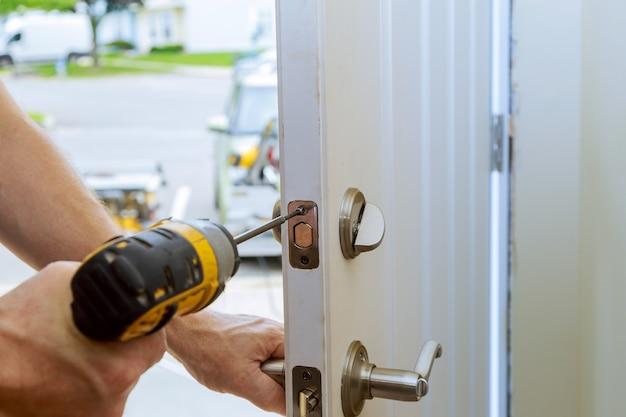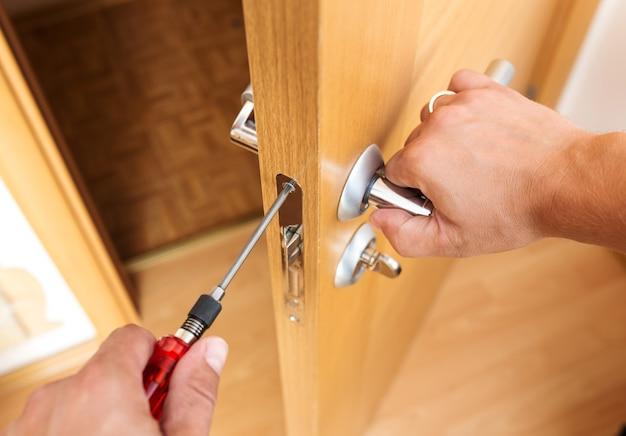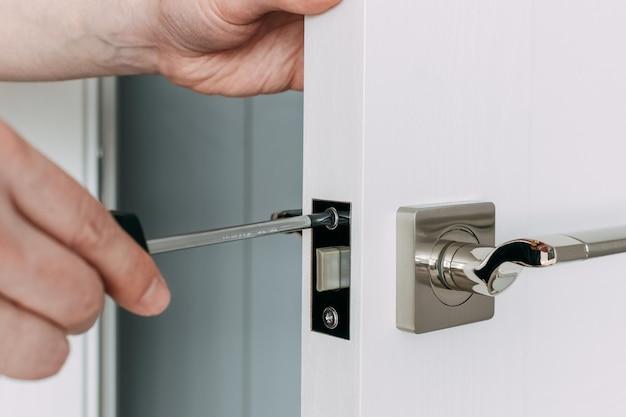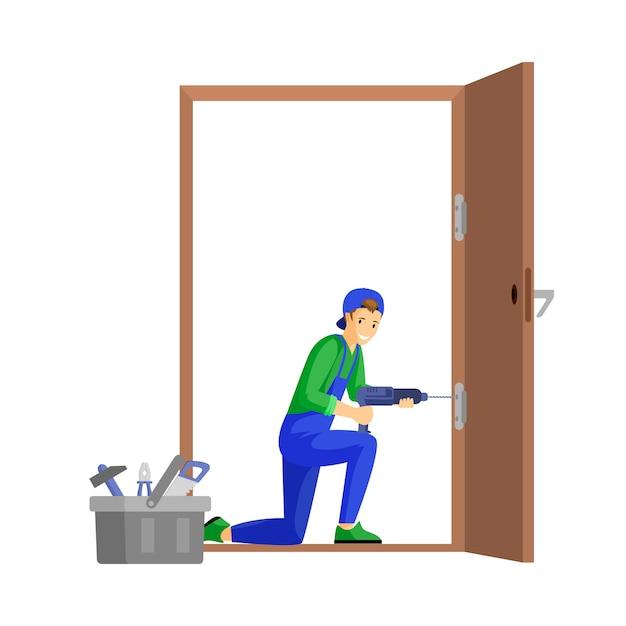If you’ve gone through foundation repair, then you may have noticed that your doors no longer close properly. This is because foundation repair can cause your house to shift and settle, which can affect its alignment.
However, don’t worry. This post is here to guide you on how to fix doors after foundation repair. Before we dive into the nitty-gritty, let’s answer some common questions.
Firstly, is foundation repair permanent? Yes, it is permanent. The foundation repair process reinforces your home’s foundation, which means that it won’t require any further repair.
But what about backfill after foundation repair? You may have heard that backfilling can cause your home to shift again. Rest easy, backfill after foundation repair is crucial to stabilize your home’s foundation, and it won’t cause any additional damages.
Now, what should you expect after foundation repairs? Usually, you’ll notice cosmetic damages such as cracks and gaps. These are normal and can be easily fixed.
But the most pressing question is, is your house safe after foundation repair? Yes, your home is now safer than it was before the repair.
However, you may still be experiencing issues such as sticking doors. Stick around, and we’ll show you how to fix this issue.
Lastly, do sticking doors always mean foundation problems? Not necessarily. Sticking doors can also be caused by other factors such as humidity and weather changes. Therefore, it’s essential to assess the root of the problem before jumping into conclusions.
Now that we have answered some common questions, let’s get started on how to fix your doors after foundation repair.
How to Fix Doors after Foundation Repair
If you have recently had foundation repair done in your home, it’s common to experience some issues with your doors. Foundation repair can cause your doors to become misaligned, making them difficult to close, open, or latch properly. But don’t worry, fixing your doors is not as complicated as you might think. Here are some steps you can take to get your doors back in working condition.
Adjust the Strike Plate
The most common issue with door misalignment is the strike plate. The strike plate is the metal plate on the door jamb where the latch or deadbolt goes into. Check the strike plate to see if it’s aligned properly with the latch or deadbolt. If it’s not, you’ll need to adjust it.
To adjust the strike plate, remove the screws that hold it to the jamb and reposition it slightly. Use a pencil to mark the new position of the screw holes on the jamb. Drill new pilot holes for the screws and reattach the strike plate.
Shave the Door
If your door is rubbing against the door jamb, you may need to shave it down. This is a bit more involved than adjusting the strike plate, but it’s not too difficult. Remove the door from the hinges and place it on sawhorses or a workbench.
Use a plane or belt sander to remove just enough wood from the side of the door that’s rubbing against the jamb. Rehang the door and see if it closes properly. If it’s still not closing correctly, repeat the process until you get a good fit.
Replace Hinges
If your door is sagging or hanging unevenly, you may need to replace the hinges. This is because the foundation repair may have caused the door frame to shift, making the hinges no longer fit properly.
To replace the hinges, remove the screws that hold the old hinges to the jamb and door. Install the new hinges in their place, making sure they are aligned properly.
In conclusion, fixing doors after foundation repair is a task that requires proper attention and care. By following the steps outlined above, you can fix misaligned doors and ensure that they function efficiently. Don’t hesitate to consult a professional if you’re unsure about any steps involved in the process.
Is Foundation Repair Permanent
If you’re wondering whether foundation repair is permanent, the answer is yes and no.
Foundation repair can be considered a permanent solution to foundation problems, but that doesn’t mean the foundation won’t settle or move again in the future.
This is because there are a variety of factors that can cause foundation problems, and there’s no way to guarantee that those factors won’t affect your foundation in the future. However, with proper maintenance and care, you can help ensure that your foundation stays stable over time.
Factors That Affect Foundation Stability
There are several factors that can impact the stability of your foundation, including:
Soil Conditions
Soil conditions play a significant role in the stability of your foundation. If the soil beneath your foundation is too dry or too wet, it can lead to settlement, heaving, or other problems.
Water Damage
Water damage is a common cause of foundation problems. If your foundation is exposed to moisture for an extended period, it can weaken the foundation and lead to settlement or cracking.
Drainage Issues
If your property doesn’t have proper drainage, water can pool around your foundation and cause damage over time.
Poor Construction
Poor construction practices can also lead to foundation problems. If your foundation wasn’t built properly, it may be more susceptible to settling or movement.
How to Ensure a Stable Foundation
While there’s no way to guarantee that your foundation won’t have problems in the future, there are steps you can take to help ensure its stability. These include:
Regular Inspections
Regular inspections can help you identify foundation problems before they become major issues.
Proper Drainage
Ensuring proper drainage around your property can help prevent water damage to your foundation.
Moisture Control
Keeping the moisture levels consistent around your foundation can help prevent settlement and cracking.
Professional Repair
If you do experience foundation problems, it’s important to have them addressed by a professional as soon as possible. A trained professional can help identify the root cause of the problem and provide a reliable solution.
In conclusion, while foundation repair can be a permanent solution to foundation problems, it’s important to remember that there’s no guarantee that those problems won’t recur in the future. However, by taking proper care of your foundation and identifying and addressing any issues as soon as possible, you can help ensure its stability over time.
Backfilling after Foundation Repair
Now that the foundation is fixed, it’s time to focus on backfilling. Backfilling is one of the most critical parts of the foundation repair process. It refers to the process of filling the gap between the foundation and the soil that was dug up for the repair.
Preparing for backfilling
Before backfilling, it’s essential to prepare the area to ensure that the backfill material is suitable for the job. The first step is to remove any debris or loose soil from the area. Make sure it is clean of any rocks, stones, or clumps of soil.
Choosing the right backfill material
Once the area is clean, it’s time to choose the right backfill material. Common materials used for backfill include sand, pea gravel, and crushed rocks. Each material provides different benefits, so it’s essential to pick the one that is suitable for your situation.
Sand is an excellent backfill material for areas where drainage is an issue. Pea gravel is ideal for areas where drainage is not an issue, and the soil needs additional support. Crushed rocks are the best backfill material for areas that require maximum support.
Backfilling properly
Now that you have the right backfill material, it’s time to start backfilling. When backfilling, it’s essential to layer the material in small increments. Aim to fill it up to two feet around the foundation at first, then work your way up slowly.
Ensure that you are compacting the backfill material as you go. Use a compactor or hand tamper to compact the material to ensure it’s tight and secure. This will prevent any settling in the future.
Backfilling is a crucial part of the foundation repair process. If you do not backfill properly, your doors may not open or close correctly, which could cause issues down the road. By following these steps and using the right backfill material, you can ensure that your foundation repairs are sturdy, secure, and long-lasting.
What to Expect After Foundation Repairs
If you’ve recently had foundation repairs done in your home, you may be wondering what to expect. Fortunately, the process isn’t as daunting as it may initially seem. Below are some of the most common steps to expect after foundation repair:
Monitoring Period
After foundation repair, there is typically a monitoring period where your foundation repair specialists will evaluate the success of the repair to ensure it is holding up as it should. This can take anywhere from a few weeks to several months, depending on the severity of the original damage.
Cosmetic Repairs
Once the monitoring period is complete, cosmetic repairs can begin. This can include cosmetic repairs to drywall or painting works. You may also need to fix any issues with doors, windows or flooring.
Maintenance
Regular maintenance is essential to keep your foundation intact, and to help prevent future damage. Consider investing in foundation repair warranty right after the repair to safeguard against any future damage.
Plan For Future
While foundation repairs usually point the way toward a more secure foundation, it’s vital to remember that your home’s foundation will continue to settle over many years. So, it’s crucial to have plans on maintaining the foundation in the future – by scheduling inspections and regular maintenance.
After foundation repair, it’s critical to monitor the state of the foundation and plan for future repairs. Though it may seem daunting, you can rest easy knowing that with careful maintenance, your home’s foundation can remain stable for years to come. Ensure that you have all the necessary details on what to expect after foundation repair by working closely with your foundation repair specialists. With their help, your home will remain both safe and structurally sound.
Is Your House Safe After Foundation Repair
Foundation repair is essential for maintaining the structural integrity of your house. But after the repair, the question on every homeowner’s mind is, “Is my house safe now?” The answer is a resounding yes!
Signs That Your House is Safe After Foundation Repair
After the foundation has been repaired, you will notice several signs that indicate your house is safe and stable. Here are some things to look out for:
No More Cracks
One of the most visible signs that your house is safe after foundation repair is the disappearance of cracks. Cracks are a sign of foundation problems, and repairing the foundation will eliminate them.
Level Floors
Level floors are another indication that your house is stable. If you had sloping floors before the foundation repair, they should now be level.
No More Sticking Doors or Windows
Before foundation repair, doors and windows may have stuck or jammed due to the uneven foundation. After the repair, you should notice that doors and windows open and close smoothly.
No More Water Damage
Water damage can happen due to foundation problems. After the foundation repair, any water damage should have stopped.
In summary, a house is safe after foundation repair. Signs that indicate your house is safe include no more cracks, level floors, no more sticking doors or windows, and no more water damage.
Why Won’t My Doors Close After Foundation Repair
If you’ve recently had foundation repair done on your home, you may have noticed that your doors no longer close properly. This can be frustrating, especially if you’ve spent a lot of time and money on the repair. Don’t worry; you’re not alone. In this section, we’ll discuss some reasons why your doors may not be closing properly and what you can do to fix them.
Shifting of Foundation
One of the main reasons why doors won’t close after foundation repair is that the foundation may have shifted slightly during the repair process. This can cause your door frames to become misaligned, preventing the doors from closing properly. If you suspect this is the case, you may need to adjust the hinges on your doors or even shave down the door frames to ensure a proper fit.
Moisture Changes
Another possible reason why your doors won’t close after foundation repair is that your home’s moisture levels may have changed as a result of the repair. This can cause the wood in your doors to expand or contract, which can also lead to misalignment. To address this issue, you may need to adjust the hinges on your doors or install weatherstripping to prevent moisture from affecting your doors.
Warping of Doors
If your doors are made of wood, they may have warped over time, which can also lead to misalignment. This can make it difficult or impossible to close your doors properly. To fix this issue, you’ll need to replace the warped door with a new one that fits properly in the frame. Alternatively, you can sand or plane down the warped door to make it fit properly.
In conclusion, there are many reasons why your doors may not be closing properly after foundation repair, but don’t worry; most of these issues can be easily fixed with a little bit of effort. Whether you need to adjust the hinges, install weatherstripping, or replace a warped door, there are many DIY solutions available. With a little bit of patience and determination, you can get your doors to close properly again in no time.
Do sticking doors always mean foundation problems
If your doors are sticking, it doesn’t necessarily mean you have foundation problems. There can be several reasons why your doors are sticking, like humidity or warping. Here are some other reasons why your doors might be sticking:
Uneven floors
Uneven floors can cause doors to stick. If your floors are uneven, the door frame might not be level, causing the door to stick. In this case, fixing the floors should solve the issue, not foundation repair.
Loose hinges
Loose hinges can also cause doors to stick. Check to see if the hinges are loose and fix them. If the hinges are already tight, try lubricating them to see if that solves the problem.
Worn-out door latch
If the door latch is worn out, it won’t close properly, causing the door to stick. Inspect the door latch and replace it if necessary.
While sticking doors don’t always mean foundation problems, it’s essential to monitor your foundation if you’re experiencing other symptoms, like cracks in the walls or sagging floors. It’s also a good idea to get regular inspections to stay on top of any potential foundation issues.
In conclusion, sticking doors can be caused by many things, and foundation problems are not always the culprit. Check for uneven floors, loose hinges, and worn-out door latches before jumping to conclusions about the state of your foundation.



